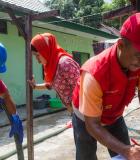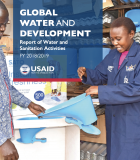When the 2010 earthquake hit Haiti, the country had just undertaken a massive reform of its water sector. The recovery from the initial disaster and subsequent cholera outbreak shifted the focus from structural reform to disaster response. An outpouring of international assistance helped Haiti dig itself out of these disasters and rebuild its infrastructure. However, the country still struggles to deliver adequate and reliable water at the household level, and the 2009 effort to decentralize its water service has made little progress in improving services or creating self-sustaining local water utilities.
The USAID Water and Sanitation Project stepped in to address this gap in 2017 with the goal sustainably providing water to 250,000 people and sanitation services to 75,000. In doing so, USAID partners with other donors and the Government of Haiti to leverage infrastructure and cholera-related funding to fill a significant capacity gap that is essential to improving service delivery in the country. At the beginning of the project, only 6,300 households had paid connections to the public water utility systems in the five targeted project areas, includings Cap Haïtien, Haiti’s second largest city. The previously dysfunctional billing and collections have been insufficient to cover salaries, let alone utility operations or service expansion.
Read the full article on Global Waters on Medium.






